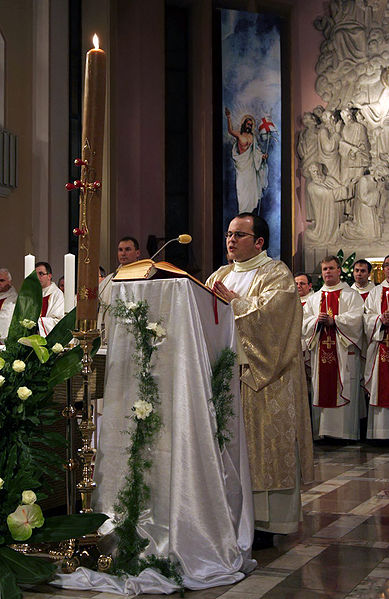Because the new liturgical day begins at sunset, the vigil begins between sunset on Holy Saturday and sunrise on Easter Sunday outside the church, where an Easter fire is Paschal candle is blessed and then lit. This Paschal candle will be used throughout the season of Easter, remaining in the sanctuary of the church or near the lectern, and throughout the coming year at baptisms and funerals, reminding all, that Christ is "light and life."
Once the candle has been lit there follows the ancient and dramatic rite of the Lucernarium, in which the candle is carried by a priest through the nave of the church, itself in complete darkness, stopping three times to chant an acclamation such as "Christ our Light" or "Light of Christ" (Lumen Christi), to which the assembly responds "Thanks be to God" or "Deo Gratias." This ceremony was once common in the Church, often occurred at Vespers and is still retained by Lutherans as official Vespers liturgical practice. Some congregations have restored this practice at Vespers, but it is most commonly seen at the Easter Vigil.
As the candle proceeds through the church, all present (ie those who have received the "Light of Christ") receive candles which are lit from the Paschal candle. As this symbolic "Light of Christ" spreads throughout those gathered, the darkness is decreased.
Once the candle has been placed on its stand in the sanctuary, the lights in the church are switched on and the assembly extinguish their candles (although in some churches, the custom is to continue the liturgy by candlelight until the Gloria).
The priest, deacon or a cantor now chants the Exsultet (also called the "Easter Proclamation" or "Paschal Praeconium"), after which the people take their seats as the liturgy of the word begins.
The Liturgy of the Word consists of seven readings from the Old Testament, although it is permitted to reduce this number for pastoral reasons (if reduced, it is customary to use readings 1, 3, 5 and 7). The account of the Israelites' crossing of the Red Sea is given particular attention in the readings since this event is at the centre of the Jewish Passover, which Christians believe Christ's death and resurrection is the fulfillment of. Each reading is followed by a psalm and a prayer relating what has been read in the Old Testament to the Mystery of Christ. After these readings conclude, the candles are lit on the altar and the Gloria in Excelsis Deo is sung for the first time since before Lent (with the exception of Holy Thursday, as well as any solemnities or feasts that occurred during Lent), and the church bells and the organ, silent since that point on Holy Thursday, are sounded again - although it is customary in some churches to have no organ playing during Lent at all, except when accompanying hymns. (In the pre-Vatican II rite, the statues, which have been covered during Passiontide, are unveiled at this time.) The opening collect is read. A reading from the Epistle to the Romans is proclaimed, followed by the chanting of Psalm 118. The Alleluia is sung for the first time since the beginning of Lent (or, in the pre-Vatican II rite, since Septuagesima) - however, it is a very solemn alleluia at this time. The Gospel of the Resurrection then follows, along with a homily.
After the conclusion of the Liturgy of the Word, the water of the baptismal font is solemnly blessed and any catechumens and candidates for full communion are initiated into the church, by baptism and/or confirmation, respectively. After the celebration of these sacraments of initiation, the congregation renews their baptismal vows and receive the sprinkling of baptismal water. The prayers of the faithful (of which the newly baptised are now a part) follow.
After the prayers, the Liturgy of the Eucharist continues as usual. This is the first Mass of Easter Day. During the Eucharist, the newly baptised receive Holy Communion for the first time. According to the rubrics of the Missal, the Eucharist should finish before dawn.
.


No comments:
Post a Comment